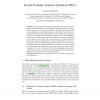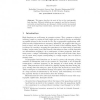CISC
2009
Springer
14 years 5 months ago
2009
Springer
Abstract. ESSENCE is a family of cryptographic hash functions, accepted to the first round of NIST's SHA-3 competition. This paper presents the first known attacks on ESSENCE....
ACISP
2010
Springer
14 years 5 months ago
2010
Springer
Many applications using cryptographic hash functions do not require collision resistance, but some kind of preimage resistance. That's also the reason why the widely used SHA-...
AC
1998
Springer
14 years 6 months ago
1998
Springer
This paper describes the state of the art for cryptographic hash functions. Different definitions are compared, and the few theoretical results on hash functions are discussed. A...
IEICET
2008
14 years 7 months ago
2008
Cryptographic hash functions have been widely studied and are used in many current systems. Though much research has been done on the security of hash functions, system designers ...
ASAP
2010
IEEE
14 years 7 months ago
2010
IEEE
Many applications require protection of secret or sensitive information, from sensor nodes and embedded applications to large distributed systems. The confidentiality of data can b...
CHES
2010
Springer
14 years 8 months ago
2010
Springer
The need for lightweight (that is, compact, low-power, low-energy) cryptographic hash functions has been repeatedly expressed by application designers, notably for implementing RFI...
AC
1997
Springer
14 years 11 months ago
1997
Springer
This paper describes the state of the art for cryptographic primitives that are used for protecting the authenticity of information: cryptographic hash functions and digital signat...
MYCRYPT
2005
Springer
15 years 18 days ago
2005
Springer
Recently, some collisions have been exposed for a variety of cryptographic hash functions [20,21] including some of the most widely used today. Many other hash functions using simi...
EUROCRYPT
2005
Springer
15 years 19 days ago
2005
Springer
Abstract. MD5 is one of the most widely used cryptographic hash functions nowadays. It was designed in 1992 as an improvement of MD4, and its security was widely studied since then...
EUROCAST
2007
Springer
15 years 1 months ago
2007
Springer
Cryptographic hash functions are security primitives that compute check sums of messages in a strong manner and this way are of fundamental importance for ensuring integrity and au...



